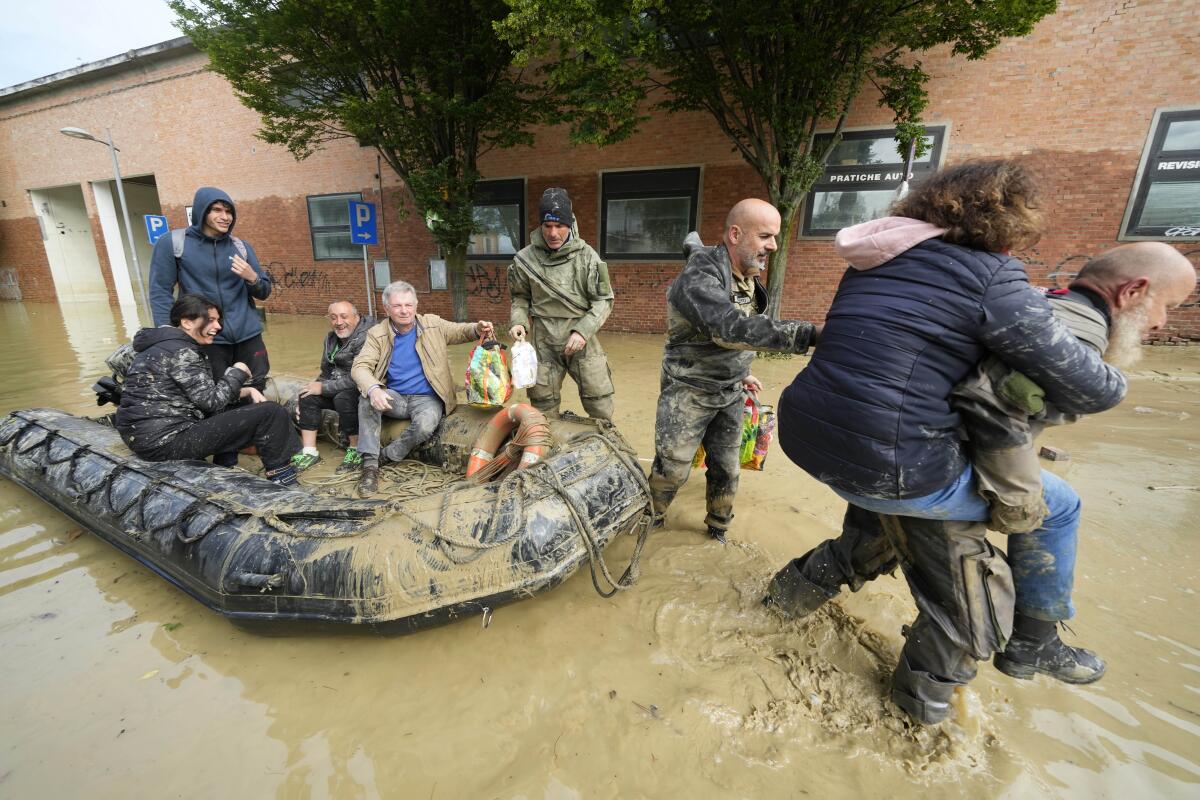Crews work to reach flooded Italian towns as toll rises to 13 and cleanup begins

- Share via
FAENZA, Italy — Rescue crews worked Thursday to reach towns and villages in northern Italy still isolated by heavy rains and flooding, as the death toll rose to 13 and authorities began mapping out cleanup and reconstruction plans.
The extreme weather behind this week’s disaster — a prolonged drought punctuated by 36 hours of intense rainfall, two weeks after another downpour — led to two dozen rivers and tributaries bursting their banks. The force of water sent torrents of mud tearing through entire towns in Emilia-Romagna, flooding storefronts and basements.
Local mayors warned that some remote villages were still completely cut off because landslides had made roads impassable and phone service remained severed. That has prevented rescue teams from reaching residents and authorities from understanding the full scope of their needs, said Mercato Saraceno Mayor Monica Rossi.
“If it rains any more, the situation will be tragic,” Rossi warned on the news channel Sky TG24, standing on a road with a chunk missing from a landslide.
The death toll rose to 13 after more bodies were discovered Thursday in the hard-hit province of Ravenna, state-run RAI television reported, citing the Ravenna prefecture. Among them: a couple in their 70s found dead in their flooded apartment in Russi after their son sounded the alarm that he had lost contact with them.
Some parts of the city of Faenza remained underwater Thursday morning, with cars submerged and basements swamped by thick, gooey mud. One family standing on their balcony said they didn’t have electricity, gas or food. Other residents took shelter at a local gymnasium, where soldiers set up cots on the basketball court for new arrivals.
“At some point they told us all to leave the area, and about one hour later we heard a loud boom,” 29-year-old Faenza resident Claudia said Thursday, recalling the moment early Wednesday that the nearby Lamone river burst its banks. “The water just flooded all over.”
More than 10,000 people fled their homes, some plucked from rooftops or balconies by rescue helicopters and others ferried out on dinghies. One family with a 20-day-old baby was rescued Thursday morning, said Cesena Mayor Enzo Lattuca. Another packed their belongings into an inflatable pool, which they floated down the thigh-high river of mud that was previously a street.
But residents in other towns, such as Castel Bolognese, started cleaning up as the waters receded, with residents shoveling out mud-filled basements and storefronts.
The drought-parched region had already estimated about $1.1 billion in losses from heavy rains this month, but the regional president, Stefano Bonaccini, said the losses were now in the multiple billions given the widespread damage to farmland, storefronts and infrastructure.
Italian farm lobby Coldiretti said more than 5,000 farms with greenhouses, nurseries and stables had been flooded, covering thousands of acres of vineyards, fruit groves and vegetable and grain fields. It said the damage was “incalculable,” because not only current harvests but also future ones could be affected, given the permanent damage to roots from the “suffocating” mud of the runoff.
Bonaccini has called for the national government to declare a state of emergency, something that is likely when the Cabinet meets next week after Prime Minister Giorgia Meloni’s return from the summit in Japan of the Group of 7 leading industrialized nations. Already, the region has said it is looking to reconstruction efforts and restoration of vital infrastructure.
“It will take gigantic work” to recover, Bonaccini told a daily briefing.
The Superior Institute for Environmental Protection and Research has identified Emilia-Romagna as one of the most at-risk Italian regions for flooding, where both territory and populations face a greater danger of “hazard scenarios” than the rest of the country.
The hardest-hit eastern part of the region, sandwiched between the Apennine mountain chain and the Adriatic Sea, was inundated by intense rain earlier this month. The second downpour tested the ability of drought-parched soil to absorb water, the institute said, adding that high sea elevations and bora winds against the coast may have contributed to the flooding of rivers and tributaries.
Pope Francis sent a telegram of condolences to the people of Emilia-Romagna, assuring them of his prayers, the Vatican said Thursday.
Italy wasn’t alone in coping with heavy rainfall, as parts of Slovenia, Croatia and Bosnia-Herzegovina also reported flooding and landslides that necessitated evacuations.
Nicole Winfield in Rome contributed to this report.
More to Read
Sign up for Essential California
The most important California stories and recommendations in your inbox every morning.
You may occasionally receive promotional content from the Los Angeles Times.










